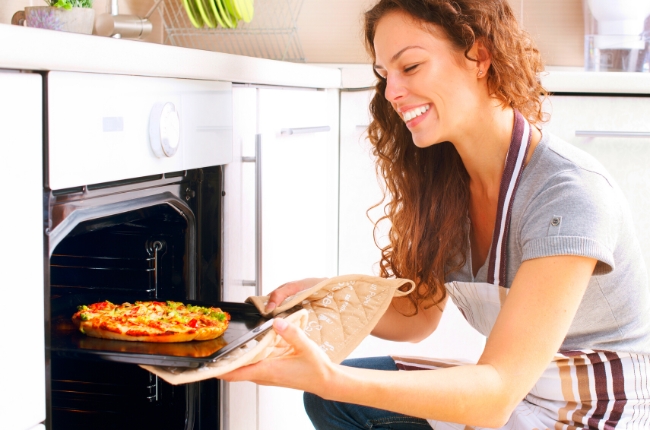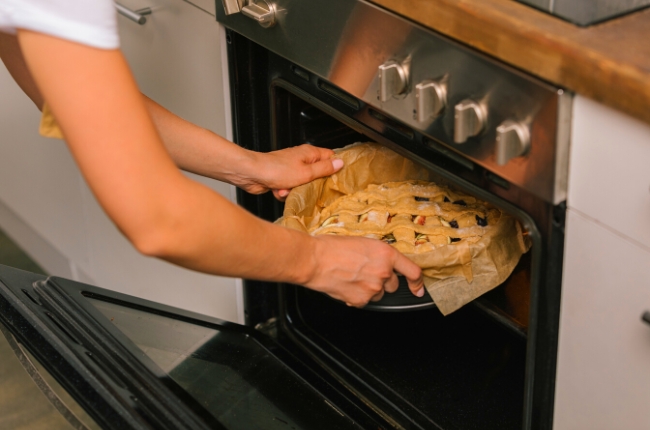You know that induction cookware is unique in its own right, so you may be apprehensive about using it for any other appliance other than intended.
But can induction pans go in the oven?
If you think of how selective induction cooktops are, you’ll likely question if anything suited for it also can be compatible with anything else. Is there a 2-in-1 option pan out there that you can use in both your oven and induction cooktop?
Let’s see!
Can you put induction pans in the oven?

“Can induction safe pans go in the oven?” Such a question can be overwhelming, TBH. It’s one thing to shop for induction-compatible pans, but another to add a criterion like being oven-safe to it!
Well, rest easy because you are not alone in your predicament!
But before you can understand how or if an induction pan works in your oven, it’s essential to dive into what makes induction cookware notably different. That way, it’s easier to understand its limits and avoid mishaps.
Understanding Induction
The benefits of induction cooking are many. It is energy efficient, safer, has more precise temperature control, and heats food quicker.
Induction cooktops have a glass ceramic surface with a metal coil at the bottom. Once you plug in your cooktop, an alternating current causes an electromagnetic field. This fluctuating field then heats the cookware directly without heating the glass surface.
Along with this modernity is the need for suitable cookware. So, what fits?
Cookware with high iron content works. This includes cast iron, enameled cast iron, and magnetic stainless steel. Those aluminum, glass, and copper cookware can work if they have stainless steel layers at the bottom.
Ceramic, wood, and stoneware are not induction-compatible.
Aside from the material, flat-bottomed cookware is preferable for even heating. Still, it’s not required, unlike in electric cooktops, where direct contact with the glass surface is necessary to heat the cookware.
You can even put a newspaper or a kitchen towel underneath your induction pan, and it will still heat up.
There’s induction 101 for you!
An oven, like an induction cooktop, has pretty strict standards regarding what you can stick inside it.
For induction, the material needs to be ferromagnetic. Meanwhile, oven-safe induction pans emphasize temperature.
Does induction safe mean oven safe?

Well, not necessarily.
For something to be considered “oven-safe” induction cookware, it must be made of magnetic material and can withstand high temperatures. And as you may know, not all cookware has these properties.
Often, manufacturers specifically label their pots and pans to guide the user. For example, induction cookware has the following labels: induction-ready, induction-safe, induction-compatible, or induction-suitable.
To further help you, let’s find out what one actually means when they say “oven-safe”.
How do I know if a pan is oven-safe?
Oven-safe cookware has won many hearts for a reason. The seamlessness of transferring from stove to oven without changing pans certainly appeals to one’s convenience and wallet.
With everything in the market nowadays, it’s not easy to ascertain what is genuinely oven safe from something that may get damaged by the oven or can wreak havoc in your oven.
Oven-safe cookware is a type of cookware that can withstand heat up to 500 F. For example, caramelization requires up to 350 F, while perfect pizzas and bread need high-temperature settings of up to 500 F.
It is certainly not a job for fragile pans!
Let’s look into the primary checks that you must carry out before putting anything in the oven.
- An oven-safe mark is your trusted signal that you can move your cookware from stove to oven without the danger of fire breaking out or cracks developing.
- Plastic is a total no-no! It melts at high temperatures and may cause damage to the oven.
- Non-stick surfaces may not withstand high temperatures. Prolonged exposure of the non-stick coating to high temperatures will cause it to degrade gradually, releasing harmful toxins.
- Be particular about the material of your cookware. Not all are oven-safe. Wooden cookware and handles are prone to warping and splitting. To some degree, stoneware may survive at 350F before breaking.
If you are still unsure what material will suit your needs, here is a list of what you can rely on.
Metals
One thing you wouldn’t want from your metal cookware is to react chemically at high temperatures. You also don’t want it to be a poor conductor of heat.
That said, you can likely rely on the following to be oven-safe:
- Cast iron and enameled cast iron offer durability and excellent thermal diffusion and, in the case of raw cast iron, become non-stick when well-seasoned.
- Stainless steel is another popular choice since the material can withstand high temperatures without the chance of warping or breaking. It also costs relatively cheaper.
- Carbon steel is a hybrid of the former two. You don’t really see this type of cookware at home, but more likely in a professional setting. It is considerably lighter than cast iron but retains its excellent thermal capabilities.
- Aluminum is light and conducts heat well. It is also corrosion-resistant.
- Copper is another material with excellent thermal diffusion and is oven-safe up to 500 F.
Ceramics
Foremost, you must ensure that your ceramics have an oven-safe mark. You must not use ceramics with adhesive designs or glazed as these cannot withstand the oven temperature.
Oven-safe glass
While glass isn’t a typical oven choice, there is a special glass that you put inside the oven without worry. An example of such is tempered glass. Even so, it would be best if you still took the precaution of inspecting the temperature range it can withstand.
Silicone
Silicone is a relatively good conductor of heat. They can also withstand high temperatures.
Perhaps, the only downside with them lies in their “inferior” look. However, if you are someone who would instead look at colorful and exciting designs, then silicone is a good buy.
Now that you have general knowledge of what materials are oven-safe, it’s time for a crossover with your favorite induction! Can induction-ready pans go in the oven?
Spoiler alert: Yes. (But not all!)
Does induction ready mean oven safe?

You probably noticed some materials are highly compatible with induction and oven use. Again, you require cookware that is ferromagnetic and safe at high temperatures.
With this, you can reliably add these types of cookware: cast iron, enameled cast iron, stainless steel, aluminum, and copper with stainless steel layers (often marketed as five-ply).
Can a stainless steel induction pan go in the oven?
As mentioned above, stainless steel is among the best materials you can choose for your induction range. It is highly durable, has an excellent cooking performance, is relatively easy to clean, and requires little maintenance. Unlike other metals like cast iron, it is highly affordable and lightweight.
A grade 430 stainless steel has a melting point of around 2600 F! So you don’t need to worry about warping any sooner.
Be extra cautious about the handles. Always remember that plastic and wood are unsuitable, so ensure everything checks out to avoid a fire hazard.
Can Cuisinart induction pans go in the oven?
If you have been in the culinary world long enough, you’d know that Cuisinart is among the brands universally recognized for its kitchenware. From appliances to a wide array of kitchen accessories, Cuisinart doesn’t lack anything.
Their cookware ranges from casserole dishes to classic stock pots to fry and saucepans. Remarkably, all of their pans are oven-safe.
These are some of the collections which are oven-safe and induction-ready:
Aluminum-core
- Ceramica XT Nonstick (with silicone handles)
- Elements Pro Induction Nonstick
Stainless Steel
- Chef’s Classic Stainless
- Contour Stainless Steel
- French Classic Tri-Ply Stainless
- Professional Series
- Multiclad Pro Triple Ply Stainless
- Hammered Tri-Ply
- Copper Tri-Ply
You can easily find the manuals for each collection on their website. For more options, you can also use their filter to look into cookware that is both oven-safe and induction-ready.
Word of caution: tempered glass lids can only be oven-safe up to 350 F, so always be cautious. Meanwhile, stainless steel can go up to 500 F.
Can Tefal induction pans go in the oven?
Tefal, marketed as T-Fal in the United States, is best known for their titanium- reinforced non-stick pans.
You most likely recognize them for their patented thermo-spot— a red indicator at the cooking surface’s center that signals that your pan has reached optimum temperature.
Here are examples of induction-ready cookware you can also use in the oven.
- ExpertPro Induction Compatible Stainless Steel
- Clipso Induction Compatible Stainless Steel
- Performa Stainless Steel
- Copper Elegance Stainless Steel
- Expert Clad Tri-Ply
However, you must be aware of certain parts which are not stainless steel, mainly handles. Phenolic handles with or without metal inserts can hold up to 350 F. Meanwhile, Tefal pans with silicone handles can go for 400 F, and stainless steel handles can go up to a maximum of 500 F.
Additionally, you must inspect the material of lids and knobs to see if they can withstand your intended temperature setting.
Can Circulon induction pans go in the oven?
Circulon is another world-renowned brand. They are the first to combine the advantage of hard anodized aluminum with a durable non-stick system.
However, they did not stop with their innovation and have moved on to create more impressive cookware, e.g., their Steelshield series. Additionally, their cookware allows room for modern technology, i.e., induction.
Here’s a list of induction-suitable and oven-safe cookware sets from Circulon that you can browse from their website.
- Steelshield S-series
- Steelshield C-series
- Symmetry
- Momentum
They also feature a non-stick wok from their Ultimum range that you may want to check out. It is suitable for both oven and induction and would be a great piece to have in your kitchen.
Bottomline: Can induction suitable pans go in the oven?
YES!
The culinary industry did not lag behind science, and there is now cookware that you can conveniently use for both your induction and oven. If you have an induction range, that’s certainly good news!
Often, you will find oven-safe and induction-suitable labels underneath pans. If they are not there, the manuals are your sure go-to.
It’s wise to take time to read the conditions where you can place an induction-suitable pan in an oven.

Leave a Reply